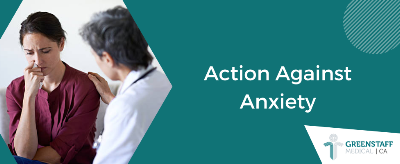
June 10, 2022, has been declared World Anxiety Day, known as Action Anxiety Day – an annual awareness and education day created by Anxiety Canada to raise awareness about anxiety disorders, eliminate stigma, and be informed about anxiety management and anxiety treatment.
While many of us try to keep our physical health in check, we often neglect our mental health. Mental health issues such as depression and anxiety, among others, affect millions of people worldwide. Stress and anxiety have become even more common following the Covid-19 pandemic, which has had an immense impact on people’s mental health.
Anxiety disorders interfere with our everyday activities, work, school, and making social connections. Stigma and access to affordable treatment can be major barriers to individuals living life the way they want, but it is important to realize that it’s okay not to be okay.
The world we live in has made it increasingly difficult to maintain a healthy mental state of mind. From busy work schedules to managing kids and school, conflict and climate disruptions to inflation rates going up, and the overall stress of the pandemic have isolated many families.
Checking up on your loved ones has never been more important.
Anxiety is a normal emotion that everyone feels now and then. It’s your brain’s way of reacting to stress and alerting you of potential danger. But anxiety disorders are different. They cause constant and overwhelming concern and fear which can affect work, school, social functions, and other situations that might trigger or worsen the symptoms.
There are many different types of anxiety disorders, but generalized anxiety disorder involves persistent and excessive worry. This ongoing worry and tension may be accompanied by physical symptoms, such as restlessness, feeling on edge, difficulty concentrating, muscle tension, or problems sleeping. The worries are often focused on everyday things such as job responsibilities, money, family health, or minor matters such as chores, car repairs, or appointments.
Anxiety disorders can also cause panic attacks when symptoms become severe. Many people who experience a panic attack may believe they are having a heart attack or other life-threatening illness. They may go to a hospital emergency department. It can become a burden to live this way which robs people of the joys of life.
Despite how common anxiety is, many people have a hard time opening up about their experience and how it affects their lives. This can prevent people from seeking the support they need because they stay silent.
A common coping mechanism is the ‘3-3-3 rule’ that “grounds us to the present moment creating mindfulness that helps us depart from unhealthy emotions” says psychologist Dr Shwetambara Sabharwal.
The psychologist recommends trying this exercise to help bring you back to the present moment when you feel your brain spiralling out of control. Take a moment to see, it, absorb it, identify and accept it.
Join Anxiety Canada and help build a society where mental health is prioritized, free of stigma and prejudice, and where treatments are more accessible. How can you ACT to support Action Anxiety Day?
Awareness/Advocacy – Raise awareness of anxiety by sharing your own anxiety stories.
Colors – Wear blue and orange on June 10 to show support and eliminate the stigma around anxiety disorders.
Treatment – Raise funds to develop trusted evidence-based resources and affordable treatments for children, teens, and adults.
It can be challenging and frustrating to live with an anxiety disorder. The constant worry and fear can make you feel tired and scared.
It can take some time to find the right treatment that works for you. For most people with anxiety disorders, a combination of medicine and counseling is best. With proper care and treatment, you can learn how to manage your symptoms and thrive.
Choose to prioritize your mental health today!
Sources:
https://indianexpress.com/article/lifestyle/health/manage-anxiety-mental-health-3-3-3-rule-7647177/
https://www.anxietycanada.com/action-anxiety-day/
https://psychiatry.org/patients-families/anxiety-disorders/what-are-anxiety-disorders